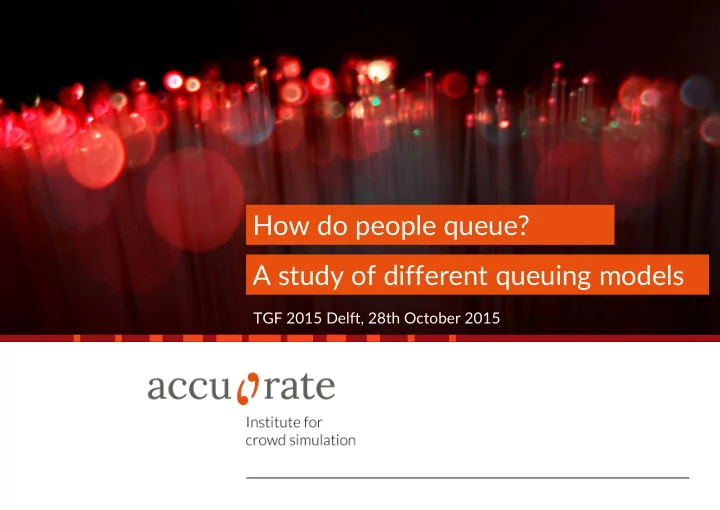

How do people queue? A study of different queuing models TGF 2015 Delft, 28th October 2015
Motivation › Whenever there are crowded spaces, queuing occurs › Such queuing evolves in many different ways, depending on: › situation › the reason for queuing › culture › geometry › … › Simulation models have to cope with such different situations and behaviors 2 accu:rate – Institute for crowd simulation
Queuing phenomena in real Queuing in front of bottlenecks Queuing in front of trains Organized Queuing in front of service desks Organized Queuing without demarcation tapes Source: www.agbf.depdfHandreichung_Sicherheitsbehoerden.pdf 3 accu:rate – Institute for crowd simulation
Queuing models at a glance Queue Type Appearance Characteristics Simulation Model (Okazaki 1993) Queuing in front of Navigational Fields with In front of bottlenecks Loosely queue formation bottlenecks adjusted velocities Queues in front of Bulk of people next to Definition of waiting At train boarding trains opening doors zones Queues formation and Organized Queuing In front of service points One-dimensional length is given by (demarcation tapes) (e.g. at airports) approach demarcation tapes Agent-based with Organized Queuing In front of service points Queue width, length and knowledge about other (no demarcation tapes) (e.g. at beer bar) form grows individually queuing people 4 accu:rate – Institute for crowd simulation
Queuing Models - Queuing in front of bottlenecks › Queuing Models uses dynamic floor fields with adapted velocities based on the Eikonal Equation (Zönnchen 2013, Köster 2014): 𝛼Φ 𝑦 ∙ 𝐺 𝑦 = 1, Φ 𝑦 = 0 in Γ With 1 𝐺 𝑦 = 𝑑 ∙ 𝐸(𝑦) c will be chosen such that the pedestrians prefer to queue behind each other: pedestrians with same destinations do not slow down the wave. 5 accu:rate – Institute for crowd simulation
Queuing at an escalator 6 accu:rate – Institute for crowd simulation
Simulation example escalator train No queuing model platform Queuing model with c=1 7 accu:rate – Institute for crowd simulation
Simulation example escalator train No queuing model platform Queuing model with c=1 8 accu:rate – Institute for crowd simulation
Queuing Models - Organized Queuing (no demarcation tapes) › Idea: agents stop at a defined stopping line › If agents already queue at this line, a spot behind the last agent is searched within a certain derivation angle. › agents start to queue as soon as the last agent in the queue is within their perception radius. › groups tend to queue next to each other › distances between queuing persons differs Example: Service Point α Agent Stopping Line 9 accu:rate – Institute for crowd simulation
Simulation results for different derivation angles stopping line service point α = 0° α = 30° α = 40° α = 60° 10 accu:rate – Institute for crowd simulation
Simulation results for groups α = 0° α = 60° service time at counter: 10 seconds Group sizes: 3 persons (25 %) 2 persons (50 %) 1 person (25 %) 11 accu:rate – Institute for crowd simulation
Summary › People do queue differently depending on the situation › Different models do exist and serve well for different occasions › A new model was introduced for organized queuing without demarcation Next Steps › Further validation of the new queuing approach › Combining different approaches in one scenario 12 accu:rate – Institute for crowd simulation
Literature › (Okazaki 1993) S. Okazaki, S.; Matsushita, International Conference on Engineering for Crowd Safety pp. 271 – 280 (1993) › (Zönnchen 2013) B. Zönnchen, Navigation around pedestrian groups and queueing using a dynamic adaption of traveling times in the Fast Marching Algorithm, Bachelorthesis at University of Applied Sciences, Munich 2013 › (Köster 2014) G. Köster, B. Zönnchen, Queuing at bottlenecks using a dynamic floor field for navigation, Transportation Research Procedia 2(0), 344 (2014). The Conference on Pedestrian and Evacuation Dynamics 2014 (PED 2014), 22-24 October 2014, Delft, The Netherlands 13 accu:rate – Institute for crowd simulation
How do people queue? A study of different queuing models TGF 2015 Delft, 28th October 2015
Recommend
More recommend